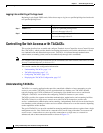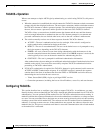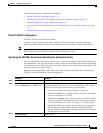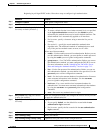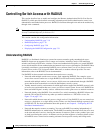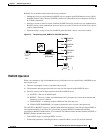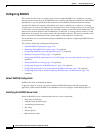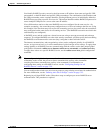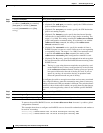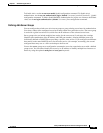
7-18
Catalyst 2950 Desktop Switch Software Configuration Guide
78-14982-01
Chapter 7 Administering the Switch
Controlling Switch Access with RADIUS
Controlling Switch Access with RADIUS
This section describes how to enable and configure the Remote Authentication Dial-In User Service
(RADIUS), which provides detailed accounting information and flexible administrative control over
authentication and authorization processes. RADIUS is facilitated through AAA and can be enabled only
through AAA commands.
Note For complete syntax and usage information for the commands used in this section, refer to the Cisco IOS
Security Command Reference for Release 12.1.
This section contains this configuration information:
• Understanding RADIUS, page 7-18
• RADIUS Operation, page 7-19
• Configuring RADIUS, page 7-20
• Displaying the RADIUS Configuration, page 7-31
Understanding RADIUS
RADIUS is a distributed client/server system that secures networks against unauthorized access.
RADIUS clients run on supported Cisco routers and switches, including Catalyst 3550 multilayer
switches and Catalyst 2950 series switches. Clients send authentication requests to a central RADIUS
server, which contains all user authentication and network service access information. The RADIUS host
is normally a multiuser system running RADIUS server software from Cisco (Cisco Secure Access
Control Server version 3.0), Livingston, Merit, Microsoft, or another software provider. For more
information, refer to the RADIUS server documentation.
Use RADIUS in these network environments that require access security:
• Networks with multiple-vendor access servers, each supporting RADIUS. For example, access
servers from several vendors use a single RADIUS server-based security database. In an IP-based
network with multiple vendors’ access servers, dial-in users are authenticated through a RADIUS
server that has been customized to work with the Kerberos security system.
• Turnkey network security environments in which applications support the RADIUS protocol, such
as in an access environment that uses a smart card access control system. In one case, RADIUS has
been used with Enigma’s security cards to validates users and to grant access to network resources.
• Networks already using RADIUS. You can add a Cisco switch containing a RADIUS client to the
network. This might be the first step when you make a transition to a TACACS+ server. See
Figure 7-2 on page 7-19.
• Network in which the user must only access a single service. Using RADIUS, you can control user
access to a single host, to a single utility such as Telnet, or to the network through a protocol such
as IEEE 802.1X. For more information about this protocol, see Chapter 8, “Configuring 802.1X
Port-Based Authentication.”
• Networks that require resource accounting. You can use RADIUS accounting independently of
RADIUS authentication or authorization. The RADIUS accounting functions allow data to be sent
at the start and end of services, showing the amount of resources (such as time, packets, bytes, and
so forth) used during the session. An Internet service provider might use a freeware-based version
of RADIUS access control and accounting software to meet special security and billing needs.



